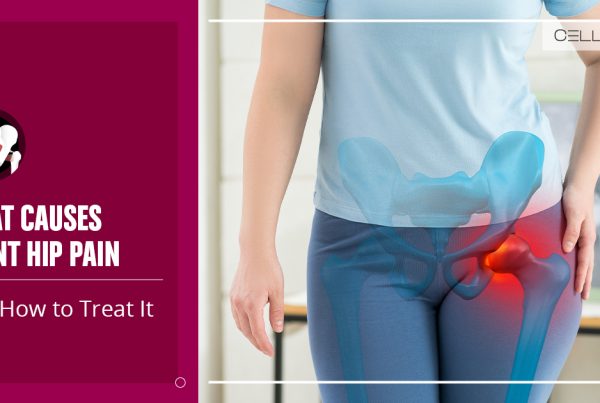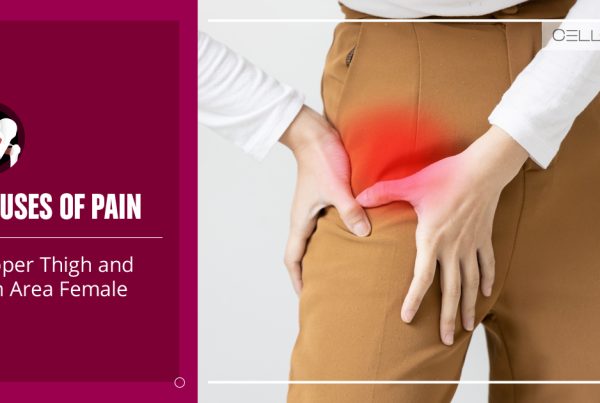Published on: October 3, 2019 | Updated on: August 29, 2024
Daily activities, from walking or running to sitting down and even sleeping, are dependant on a myriad of processes and structures in our bodies. Each joint and muscle serve a particular function in these movements.
Our gluteus muscles and tendons are no exception to this – they provide support and structure to most activities. If these muscles and tendons become injured, quality of life can be significantly impacted.
Tendons are a part of the human body that aid in these processes, as they connect bone to muscle. Tendonitis occurs when a tendon becomes unable to perform its normal function due to injury or deterioration over time.
Do you have Gluteus Medius Tendonitis?
Fill out the form below to schedule your FREE virtual consultation
Anatomy of the Hip
Hips are comprised of the femur (also known as the thigh bone) and the pelvic bone. Located on the femur is the greater trochanter, a part of the bone that juts out slightly under the hip joint. The gluteus medius muscle is located under the gluteus maximus muscle and makes up part of the buttocks. It attaches to the top of the femur and greater trochanter.
The other side of the muscle is attached to the pelvic bone. The gluteus medius is responsible for most ambulatory functions, as well as providing support in the hip and allowing for side-to-side motion.
Tendons are rough pieces of flesh that exist throughout the body and serve the function of attaching bone to muscle. Due to their precarious location and frequent use, they are susceptible to injury.
Tendonitis occurs when a tendon becomes stressed and inflamed. There are several potential causes of tendonitis, such as:
- Exercise: regular exercise that stresses the gluteus maximus, such as lunges, squats, swimming, or running, may cause damage to the muscles over time. Athletes who participate in high-impact sports are more prone to these types of injuries.
- Repetitive motion: doing the same motions over and over again can put stress on the tendons, which leads to pain and inflammation.
- Injury: certain injuries may leave an individual with symptoms of tendonitis if the tendon becomes torn or deteriorated.
- Abnormal bone structure: in some cases, a physical abnormality in bone alignment can cause extra damage to be done to tendons.
- Degeneration: soft tissue in the body degrades over time, eventually changing the structure of a joint or muscle arrangement. This change can lead to the pain commonly associated with tendonitis.
Whatever the cause may be, it is imperative that an individual is completely honest with their doctor about the degree and nature of their pain.
Signs and Symptoms
The symptoms of tendonitis are similar to those of impingement, so it is important to have an accurate diagnosis of what is causing pain in the hip. In the case of a gluteus medius injury, some of the more prominent symptoms are:
- Pain in the lateral hip area (not in the groin).
- A pinching sensation, especially during certain activities such as standing up or sitting down.
- Dull aching sensations or numbness.
These symptoms can occur chronically, or only during certain activities. They can appear quickly, as in the case of injury, or creep up over time. Some individuals, such as for overweight women, arthritis patients, or athletes, are more prone to gluteus medius tendonitis, but it can occur to anyone at any time.
Conditions that might produce similar symptoms include hip osteoarthritis, hip impingement, and trochanteric bursitis. Receiving the proper diagnosis from a doctor can vastly impact the recovery process.
Diagnosis

Soft tissue injuries are often diagnosed via several methods. Initial meetings with doctors will begin with minimally invasive tests. If these fail to provide patients with a proper diagnosis, more invasive methods will be used. These include:
- Physical Examination: doctors will begin by watching a patient walk, as well as try out several ranges of motion tests that can determine the location of the pain. Some patients with gluteus medius tendonitis develop a limp which doctors can observe to better diagnose the injury.
- MRI: Magnetic Resonance Imaging can be used to capture a picture of soft tissues in the body. When an injury is located in a tendon or muscle, this type of imaging is used to pinpoint the location that is causing pain in patients.
- X-rays and CT Scans: this type of imaging is used less often for injuries to soft tissue, but can be used to determine structural abnormalities in the bone that may be causing an issue.
- Ultrasound: similar to an MRI, ultrasounds can produce an image of soft tissue which can aid in diagnosis.
Diagnosing any injury correctly can be crucial to a patient’s overall satisfaction in the recovery process. Once doctors are certain of what they are treating, they can formulate a recovery plan that is specific to each patient.
Treatment of Gluteus Medius Tendonitis
For most injuries to soft tissue such as tendon or muscle, it is recommended that a patient begins with simple treatment methods. To begin with, doctors will usually recommend the following:
- R.I.C.E.: avoiding strenuous activity to the soft tissue that is causing pain can sometimes be enough to heal an injury. This should be combined with ice, compression, and elevation of the injury.
- Anti-inflammatories: the use of over-the-counter NSAIDS (Non-Steroidal Anti-Inflammatory Drugs) such as Ibuprofen or Naproxen can combat pain that is being felt due to an injury or damage.
- Physical Therapy: if pain persists even after attempting to rest, doctors may suggest physical therapy. Some of the goals of physical therapy are to relieve pain, strengthen muscles surrounding an injury, and increase range of motion.
- Cortisone Injections: the use of corticosteroid injections delivers a strong anti-inflammatory shot into the location of an injury or damage. They have been proven to damage tissue over time, however, and should be closely monitored for this reason. Generally, cortisone improves pain for about 3 months with gluteus medius tendonitis but the pain typically returns.
A significant tear in the gluteus medius can also lead to reparative surgery, if the muscle is no longer attached to the bone or if the space between the muscle and bone has deteriorated significantly.
The main form of surgery for this injury involves stitching the tendon back onto the bone. These surgeries are performed using arthroscopy which is minimally invasive and not considered to be major surgery.
Each patient’s treatment plan will vary based on their personal needs and the nature of the injury. For example, someone who is already experiencing symptoms of arthritis will have a different plan than someone who is younger and has maintained an athletic lifestyle.
Some patients may elect alternative treatments in order to avoid surgery or corticosteroid injections.
Regenerative Medicine’s Role in Treating Tendon and Muscle Injuries
The field of regenerative medicine has been gaining traction recently due to its vast potential to heal many types of injuries. It is particularly well known for treating injury to soft tissue, such as tendonitis of the gluteus medius. Cellaxys offers two types of regenerative therapy. These include:
- Stem Cell Therapy: this form of therapy involves harvesting stem cells from a patient’s own adipose (fat) or bone marrow. The stem cells are then processed and transplanted into the site of injury. The injury site is located using imaging techniques such as live X-ray (fluoroscopy) or live Ultrasound for accuracy.
- Platelet-Rich Plasma Therapy: our blood contains platelets, which contain proteins and growth factors that are used in the body’s natural healing processes. PRP therapy involves drawing a patient’s blood and processing it so that the platelets are isolated from other components in the blood. The concentrated platelets are then re-injected into the injury site using similar imaging techniques to stem cell therapy.
Both of these types of therapy are essentially taking the body’s own natural healing powers and enhancing them. The injection process is minimally invasive, as they are outpatient procedures that typically take less than two hours. Unlike corticosteroid injections, these forms of therapy are focused on healing the tissues vs simply decreasing the inflammation.
Most patients begin to feel a decrease in pain after a couple of days, allowing them to return to their daily activities. Regenerative medicine procedures are often coupled with treatments such as physical therapy and activity modification, which can help make the recovery process more efficient.
Tendonitis injuries are particularly likely to respond well to these types of treatments, as they are sometimes able to heal on their own using the same properties. When conventional treatments are not enough to heal an injury alone, considering newer regenerative orthopedic therapies can offer hope for a speedy recovery.
Sources
Footnotes
- Schuh A, Zeiler G. Rupture of the gluteus medius tendon. Zentralblatt fur Chirurgie. 2003;128(2):139-2.
- Byrne DP, Mulhall KJ, Baker JF. Anatomy & biomechanics of the hip. The open sports medicine Journal. 2010;4(1).
- Kuhlman GS, Domb BG. Hip impingement: identifying and treating a common cause of hip pain. American family physician. 2009;80(12):1429-34.
- Thaunat M, Pacoret V, Saad M, Saint-Etienne A, Morvan A. Endoscopic treatment of gluteus medius tendon tear. Orthopaedics & Traumatology: Surgery & Research. 2022;108(8):103393.
- Labrosse JM, Cardinal É, Leduc BE, Duranceau J, Rémillard J, Bureau NJ, Belblidia A, Brassard P. Effectiveness of ultrasound-guided corticosteroid injection for the treatment of gluteus medius tendinopathy. American Journal of Roentgenology. 2010;194(1):202-6.
References
- Gluteal Tendinopathy. Cleveland Clinic. Accessed 9/12/2023.
- Treatment of Tendinopathy: What Works, What Does Not, and What is on the Horizon. National Institutes of Health. Accessed 9/12/2023.
- Arthroscopy. Mayo Clinic. Accessed 9/12/2023.
CELLAXYS does not offer Stem Cell Therapy as a cure for any medical condition. No statements or treatments presented by Cellaxys have been evaluated or approved by the Food and Drug Administration (FDA). This site contains no medical advice. All statements and opinions are provided for educational and informational purposes only.
Dr Pouya Mohajer
Author
Pouya Mohajer, M.D. is the Director of Spine and Interventional Medicine for CELLAXYS: Age, Regenerative, and Interventional Medicine Centers. He has over 20 years of experience in pain management, perioperative medicine, and anesthesiology. Dr. Mohajer founded and is the Medical Director of Southern Nevada Pain Specialists and PRIMMED Clinics. He has dedicated his career to surgical innovation and scientific advancement. More about the doctor on this page.
Dr Pejman Bady
Contributor
Dr. Pejman Bady began his career over 20 years ago in Family/Emergency Medicine, working in fast-paced emergency departments in Nevada and Kansas. He has served the people of Las Vegas as a physician for over two decades. Throughout this time, he has been met with much acclaim and is now the head of Emergency Medical Services in Nye County, Nevada. More about the doctor on this page.









